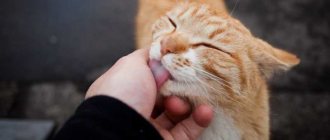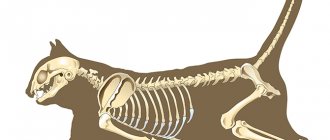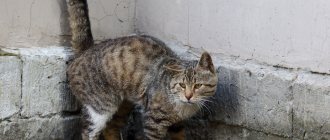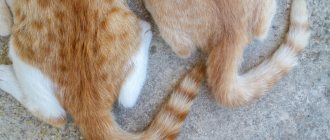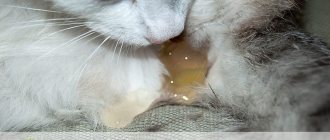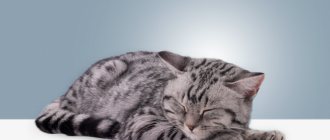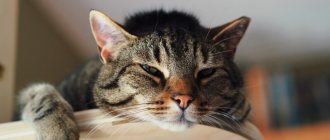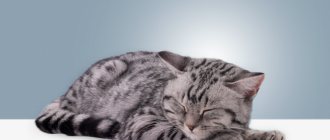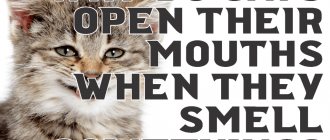Everyone knows perfectly well that if a dog wags its tail, it means it is experiencing positive emotions: it is happy, it wants to play. But not only dogs can do this. Cats also wag their tails very often, thereby showing their emotions. Only particularly attentive owners attach importance to this. But it is this small gesture that can say a lot about the mood of your furry friend. Let's look at the meaning of this action in more detail.
cat tail
Why do cats need a tail?
First, let’s look at a question that might arise in everyone’s mind: “Why do cats even need this appendage?” It seems that this is a useless part, created only for the owner to accidentally step on it.
The tail is an extension of the spine. This is where a large number of vertebrae, nerve endings, vessels and capillaries are located. He is very sensitive, so many cats don't like people touching him. If you pinch it too hard or otherwise violate its integrity, the animal will become paralyzed.
It helps the animal:
- Maintain balance;
- Orientate yourself in space;
- Walk, jump on narrow surfaces, not be afraid of falling;
- Climb trees and other tall objects;
- Track, hunt prey.
Physiological reasons
If animals were deprived of such a gift, then they would not be so fast, dexterous, and elusive.
Cat and balance
Its main purpose is balancing. If a cat is injured in this part of its body, it will not be able to walk and will constantly fall to one side.
The ability to land on its feet is also associated with this funny “appendage”. During the fall, he moves quickly, which allows him to land exclusively on his paws.
Expressing emotions
The tail has another important function. It helps to show others your mood. But some breeds do not have it, for example, the Kuril Bobtail. Animals of this breed do not have communication difficulties. He expresses his emotions by meowing, moving his whiskers, and moving his whole body.
But basically, in order to find a common language with your pet, you need to learn to read these signals.
Cats communicate
Why do cats “cover themselves” with their tail?
If a cat sits or lies covered with its tail, it is most likely scared and trying to defend itself. Seeing this, it is better to stop communicating with her and make room for her to sleep.
If your cat lies down to rest for several days with its tail tightly wrapped around itself and leaning against its body, it is worth getting examined by a veterinarian.
Although it is important to pay attention to more than just the movements of the tail to understand a cat's emotions, it remains the most expressive part of this pet's body.
Based on materials from www.petmd.com
Cats wag their tail: reasons
It is difficult for people to get used to the fact that the strength of the wagging of the fifth limb depends on emotions. It is commonly believed that this can only mean dissatisfaction, but this is not at all the case. Any emotion can be evoked in this way.
Knowing what emotion a pet is experiencing, a person can adapt to it. Imagine a situation: you are very irritated, you don’t want to see anyone at all, much less communicate or play. If someone tries to interact with you, it is unlikely to evoke positive emotions in you. The same thing happens with animals. I don’t really want to purr, run after a toy, or endure stroking when I’m not in the mood.
The following emotions may be expressed:
- Fear;
- Interest;
- Irritability;
- Anger;
- Discontent;
- Interest;
- Friendliness;
- Confidence;
- Respect;
- Indifference.
Sometimes, the same position of a limb can mean completely different things: in the absence of swings - one emotion, in intense swings - another.
In order not to get confused in the behavior of your pet, we will analyze each type of emotion separately and why the cat waves its tail in the first place.
How can you tell how a cat is feeling by its tail?
By the movement of the tail, you can not only understand the cat’s mood, but also learn something about the animal’s well-being and behavior, and even predict the weather:
Photo: Cat | Dreamstime.com
- If a cat approaches a wall (door, furniture), raises its tail horizontally and quickly shakes it, this may mean that the animal has “marked” its territory. This behavior can occur not only in males, but also in females;
- When a cat is quietly dozing or just sitting and resting, its tail is usually at rest. But as soon as you name the pet’s name, the animal instantly responds to the owner’s voice with a slight wag of its tail. The cat seems to say: “Master, I hear you”;
- Typically, sharp, chaotic movements of the tail symbolize the rage of the animal. But not always. Sometimes a pet who is not feeling well shakes its tail vigorously;
- A cat sometimes wags its tail due to stress (change of place of residence, rearrangement of furniture, appearance of a new pet in the house, etc.);
- The animal may twitch its tail and occasionally chew it due to the presence of fleas or other bloodsuckers;
- If a pet tucks its tail under itself while sitting or lying down, it means it is cool. There is even such a belief: a cat curls up and hides its tail between its paws - frost will come soon. By the way, this is not the only folk sign about a cat’s tail. It is believed that an animal can fluff its tail before a snowstorm, and lick it thoroughly before rain;
- When a furry pet lies down on the floor with its tail parallel to its back, it means it’s hot.
How to understand a cat's mood by its tail
Zoologists say that cats can wag their tails in completely different ways. Affect can reflect both negative and positive emotions. The more intense the swing, the brighter the emotions experienced.
Other animals don't have to learn the habits of cats the way people do. They understand everything on a subconscious level and read signs perfectly.
But it is worth noting that each kitten has its own character, its own habits. It is best to study the available information, but still rely on your feelings when reading emotions.
Friendliness and interest
Everyone has been familiar with the popular phrase “Tail like a pipe” since childhood. This is what they say about an energetic and cheerful person who is ready to do something good and significant.
This expression appeared precisely thanks to cats and their habits. When a cat's tail looks straight up and twitches a little, this means that the cat is positive, shows friendliness, and you evoke positive emotions in it. This is a very good sign, as the cat trusts you.
Interest in an action or a specific person or animal is expressed with the help of a raised tail with a curved tip. Very often such a reaction can be seen in those moments when the animal sees something for the first time.
You can react to an unknown object, which is quite interesting and unusual, with the help of small twitches of the furry extension of the spine.
Curled tail
Interesting fact: the cat's interest and the position of the fifth limb in this state are just an intermediate gesture. As soon as the animal deals with an unfamiliar object or gets acquainted with another living creature, it will show its attitude, change the position of its tail, in accordance with its emotions.
Gratitude and trust
Animals are grateful to their owners for many things: for delicious food, for proper care, for love and affection. If dogs show their gratitude through barking and licking, then cats are more restrained in this regard. That's why people often feel like they don't care at all. But that's not true.
Cats express gratitude and trust with the help of smooth wagging. You can talk about trust when the fluffy calmly turns his back to you, while hanging down the extension of his spine. If he does this, then he will trust you completely.
The position “Parallel to the floor” speaks about favor.
Frustration and anger
Irritation or anger is most often demonstrated by a raised tail. It is simply impossible not to notice such a gesture, as it increases several times. Most often this is accompanied by rounded, large eyes, raised fur, hissing, and wary behavior.
Rear Tail
The fur and limbs increase because in this way the cat tries to appear larger. This helps to scare the culprit of a bad mood.
Fear
If a little furry is very scared, he may begin to tuck his tail, like dogs do. This can be compared to the state of a person when, out of fear or fright, he cannot even move from his place. If a cat has its tail between its legs, it means that it is so scared that it is not even ready to resist, defend itself, and cannot run away. Often this condition is accompanied by stress, so you should not allow this to happen.
Fear can also be recognized by raised fur.
Joy
The most pleasant emotion for a cat and its owner is joy. When a cat is happy, he is ready to play, be affectionate, and easily makes contact even with strangers. Joy or pleasure can be caused by delicious food, pleasant strokes, or simply a good sleep.
The cat is happy
Joy is also expressed by raising the tail up, while its tip can be bent. The more intense the movements of the limb, the more positive emotions the cat experiences.
Irritation and defense
Dissatisfaction or irritation is often manifested by a sharp change in the speed of swings: light movements are quickly replaced by intense swings. This means that the pet is tired of attention, it is better not to touch it or pet it at the moment.
During a fight, in defense of themselves, animals often take a “fighting stance.” If you have ever seen cats fighting on the street, then you understand what we are talking about. At such moments, the tail wags left and right like a mad metronome, the animal hisses, the fur stands on end, all this is accompanied by loud screams.
Hunter Mode
Many people wonder why cats wag their tails when they are pressed to the floor or just lying down. During a hunt, the fifth limb not only helps, but also reveals the intentions of its owner. While hunting (even for an ordinary toy), a small predator presses itself to the floor and begins to beat its tail on the floor, wagging it in different directions.
Hunting
This behavior is very funny to watch, especially if the object of pursuit is some harmless thing (an elastic band, a lid, or something else).
How cats show their mood
A cat's tail consists of many vertebrae and performs a large number of functions. The main role is balancing during movement and hunting. But a cat's tail is also an expression of her behavior and character. This means that if the owner is attentive and loving, then it will be easy for him to determine the cat’s mood by the tail. It is when and how a cat shakes its tail that you can understand what mood it is in.
A cat's tail twitches in different ways - both vertically and horizontally. To figure out how to understand a cat by its tail, you need to take into account many factors. These may include:
- people unfamiliar and incomprehensible to them. For older cats, this can be a stressful environment. And if this is a cat with kittens, then the trembling tail will immediately let you understand displeasure and fear for its offspring;
- general situation in the breeder’s family. If you constantly scream and at the same time can periodically hit the kitten, you should be prepared for the fact that the cat arches its back and its tail is fluffed or tucked. But when you love and cherish your pet, then his tail will almost always be a pipe, and the threat of an arched back and hissing sounds will bypass you;
- If an animal beats its tail, meows, shakes, its pupils are dilated and it tucks or arches its tail, then the pet is letting you know that it is experiencing fear. In such a situation, it is better to remove the object that provoked panic;
- An unfamiliar environment or moving can also cause displeasure in the pet, which will be expressed in the fact that the cat jerks its fifth limb. Let her know that you are looking out for her and want the best for her.
INTERESTING TO KNOW: What to do if a cat is bitten by a wasp?
Cats can perfectly understand what you are communicating with them about. As the kitten grows up, it learns to understand its owner, and you learn how to determine its mood and how to understand your pet’s language.
Ears
The cat perked up its ears. This means that your pet is interested in what she hears around her. You may notice that your cat moves its ears to hear what is happening behind it without moving its head.
Ears are pressed to the head . If the ears are pressed to the head and turned back, then the cat feels threatened and seeks to protect them.
Head and mustache
Head raised . The meaning of this gesture varies depending on the circumstances. If the cat is happy, a raised head indicates curiosity and confidence, and is usually combined with perked ears. On the other hand, if he is in a confrontation with another cat, a raised head indicates dominance and in this case the ears will be flat against the head.
Head down . When confronting another cat, a lowered head indicates submission. In other circumstances, a lowered head may indicate sleepiness, contentment, or boredom.
Cat's whiskers . Whiskers can serve as an indicator of a cat's mood. If the whiskers are forward, the cat is relaxed, content, or curious. If they are pulled back, the cat is preparing to defend itself or attack.
Possible problems with the tail
The first thing that catches our eye when we look at a cat's tail is its shape. The tail may be obviously irregular in shape. The vertebrae of a deformed tail may protrude on top of each other, forming a “ladder.” When there are kinks, the vertebrae fold into a “ladder up,” and when there are fractures, they fold into a “ladder down.” Vertebrae with these types of deformities may have rounded edges, but they are all different sizes.
The most common form of tail deformation is a bend. One or two vertebrae can stand out from the conventional “line” of vertebrae, forming a certain angle. With such a deformation, not only the tail looks unusual, but also the deformed vertebrae themselves (the vertebral body may be irregular, asymmetrical or wedge-shaped).
One of the vertebrae is deformed and forms an obtuse bend angle
Sometimes two or three vertebrae fuse together and form a knot, this type of deformity is called knotting.
Tail fractures
Such tail defects may not bother the animal, unlike fractures. The bone marrow ends in the lumbar spine, but the nerves reach the very tip of the tail. This structure of the nervous system is called the “cauda equina.” When the tail is fractured, swelling appears, displaced bones can injure nearby muscles and tendons, so fractures are accompanied by pain. A fracture can be diagnosed using an x-ray. It is noticeable when you feel all the vertebrae in the tail, but the owner can harm his pet, so if you suspect a fracture, it is better to consult a veterinarian. If the fracture is not recognized in time and the cat is not treated, the vertebrae may not heal properly. This may not affect the cat’s health, but it will cause some discomfort.
My cat’s tail was also broken in the first year of his life - the dog bit him and fell from the fence.
Also, when you stroke it, it twitches - the veterinarian said that the nerve endings are broken somewhere, but there is nothing terrible for health. The only thing this has affected is his coordination of movements and orientation in space: he does not feel the edges of the places where he lies - he falls from the bed, chairs, etc., sometimes he misses when jumping somewhere, sometimes he “calculates” incorrectly. » their movements and falls from all elevated or uneven places. In principle, we have already gotten used to it and are trying to back him up - he is very active and nimble. Recently I broke my tail again. If the tail is broken at the very base, there are no options - just watch and observe. And if it’s in the middle or at the end, the veterinarian suggests amputation. But why is this necessary if it doesn’t bother the cat - it’s just an extra injury. Scarlet https://forums.zooclub.ru/showthread.php?t=3741
Itching and scratching of the tail
In addition to fractures and bruises, cats may have other tail-related ailments. Most often these are problems with the skin and coat. Of course, any animal whose body is covered with hair can shed periodically; this is a normal phenomenon. The longer and thicker the animal's fur, the more hair falls out during the molting period. Of greater concern is hair loss due to cat behavior. If the cat is nervous, combs its tail, chews out fur, etc., then you need to determine the reason for this behavior.
Cats may bite and scratch their tail so hard that they create sores that become itchy, causing the scratching to occur again.
Parasites
Most often, scratching, gnawing fur and other behavioral reactions occur due to the appearance of parasites. Cats can be attacked by fleas, ticks, lice eaters, etc. You can “pick up” parasites on the street (for example, while walking), in the basement or from other animals. If a cat begins to “tear” its tail, you should carefully examine it; insects may leave “evidence” on the fur in the form of small black dots. Field ticks are visible to the naked eye (you need to part the fur near the bitten area).
First, fleas settle on the animal's neck, where the cat cannot reach. Gradually they populate the entire surface of the body. If a cat frantically chews hair out of its tail, the cause may be adult, old fleas. It's difficult to get them out.
To prevent such diseases, you can purchase a special collar or drops. In addition, you need to observe hygiene standards and take care of your cat's fur. If it was not possible to protect your pet from parasites, you can contact a veterinarian: in addition to anti-flea agents, antiseptics may also be required. Wounds need to be treated (for example, with Streptocide or Syntomycin ointment). It is dangerous to burn wounds with brilliant green: the edges of the sore may heal, which will again lead to scratching. If the cat is not treated, wounds may appear along the entire length of the tail, and systematic “tearing” of the skin will lead to the appearance of ulcers. If the ulcers reach the root of the tail, the skeletal system may also be affected.
Fungal diseases
However, in addition to parasites, fungal diseases can also cause itching. Ringworm is very dangerous and if it is detected, treatment should be started immediately. Mycosis can be recognized by bald spots and light spots on the skin. It may seem like it's just a “comb” covered in dandruff.
The most common fungal disease in cats is ringworm.
Ringworm is a very contagious disease that can be transmitted to humans. Cats become infected from other animals, so professional cat breeders release newly acquired animals into the “quarantine zone.”
To prevent a cat suffering from lichen from tormenting itself with “tearing”, you can buy a special device in the form of a suppressed cone with a wide base, which is called an Elizabethan collar. It limits the mobility of the head, so the cat cannot reach the itchy areas.
The protective collar immobilizes the cat's head so that it cannot reach the tail.
You can treat lichen with special antifungal agents, which are available in any pet pharmacy. General supportive medications (vitamins) are also needed. When visiting a veterinarian, an infected cat may be given an injection.
Today at the doctor's appointment they shone ultraviolet light on my face and stomach.
There is no light on the face, everything on the belly is green. The diagnosis is ringworm. They gave me a Vakderm injection (they said it was possible from 1 month). At home - Antilichen or Stop lichen (10 days), + Trivit vitamins 1 month. After 10 days, repeat Vakderm. Chicony https://forum.bolen-kot.net.ru/index.php?showtopic=17179
Allergy
Another, but no less important problem is allergies. The reaction may occur due to contact with an allergen contained in cat litter, a plastic toy, food, etc. Allergens may also be contained in inexpensive food. If there is an allergy, the cat may scratch its body and tail (sometimes the itching leads to chewing out the fur). Redness (spots) and peeling may appear in some areas of the skin. A veterinarian can prescribe proper treatment for allergies (steroids and ointments for wound healing). In addition, it is necessary to limit the animal’s contact with the irritant.
My cat is 9 years old.
Weight 3 kg. Half Persian Diagnosis: food allergy. For the last year I lived on Proplan. Everything was fine. March-April switched to cat chow. It peeled off a lot and started to itch. Since the beginning of May we have returned to ProPlan. Hair loss and itching continue. The belly and hind legs are completely bare, the tail has become like that of a sphinx, and the ears are burning with a scarlet flame. True, the neck and front legs are in excellent condition. The doctor advised to switch to natural food, and one that was not used in feed. I cook oatmeal + a spoonful of vegetables + lamb. koshkaAdel https://mauforum.ru/viewtopic.php?t=12976
Could the condition of the tail indicate health problems in a cat?
The cat's tail expresses any dissatisfaction, even if it arose due to poor health. So, a usually calm tail, if it suddenly twitches sharply, can signal that the animal is in pain. If your pet walks with his tail raised, tip twitching, and his hind legs slightly splayed, he may have kidney stones (urolithiasis). Males are susceptible to this disease. It is accompanied by pain when urinating, so when visiting the toilet the cat will meow pitifully and “twitch” its tail. The cause of urolithiasis is an improper, unbalanced diet.
You can tell that a cat is sick by its behavior and external signs.
For example, if a cat eats mostly dry food and sometimes fish, then the body may not have enough calcium. If you feed your pet only milk, there will be plenty of calcium, but there will be a deficiency of phosphorus. Due to such disturbances in the balance of the diet, stones form in the cat.
In order to promptly detect a pet’s illness, you need to know the basic parameters of the cat’s body. The body temperature of a healthy cat is from 37.5 to 39 ° C (the younger the cat, the hotter it is). The respiratory rate also depends on age: the norm for adults is 17-23 breaths per minute, for young cats - 22-24, for kittens - up to 60. The pulse of a healthy cat is up to 130 beats per minute.
For a cat, the norm is a vertical tail position (tube tail). A cat with such a tail feels good and is happy with everything. If the tail is limp, like the cat itself, it may be sick. The most serious diseases of cats are some viral diseases and oncology. It is difficult to identify such diseases; you need to consult a specialist.
Some people get scared when they notice a cat “eating” its tail. Take a closer look, perhaps the animal is simply sucking on it. This happens if a kitten is separated from its mother early. Such animals retain the need to “suck.” The cat can choose any fluffy rag (sweater, blanket, soft toy, etc.) or its own tail as an object. To prevent the cat from swallowing the thread or lint, you can try to take the toy away from it. But as a rule, by 1.5–2 years this need disappears on its own.
